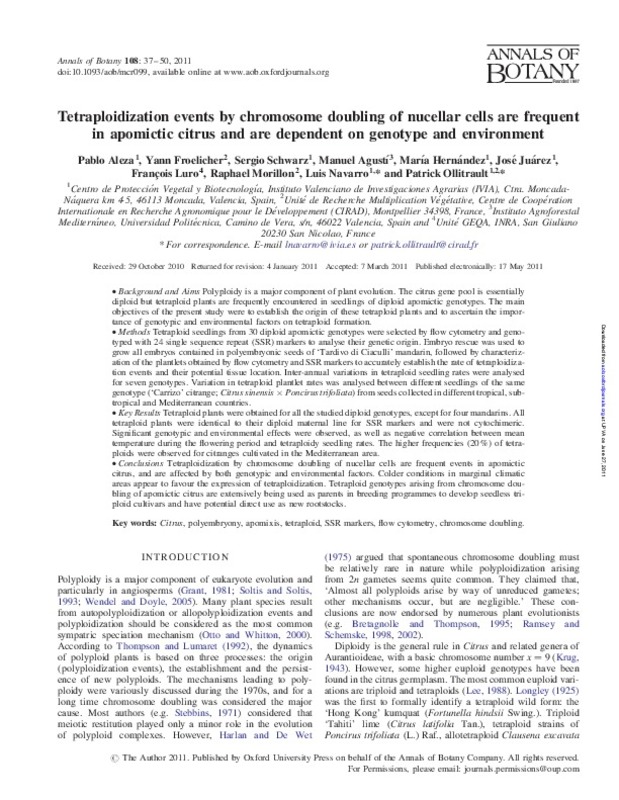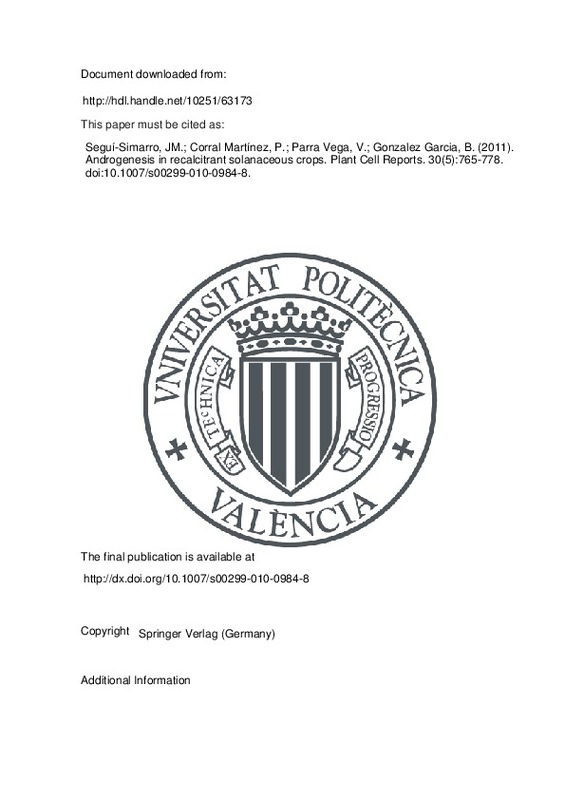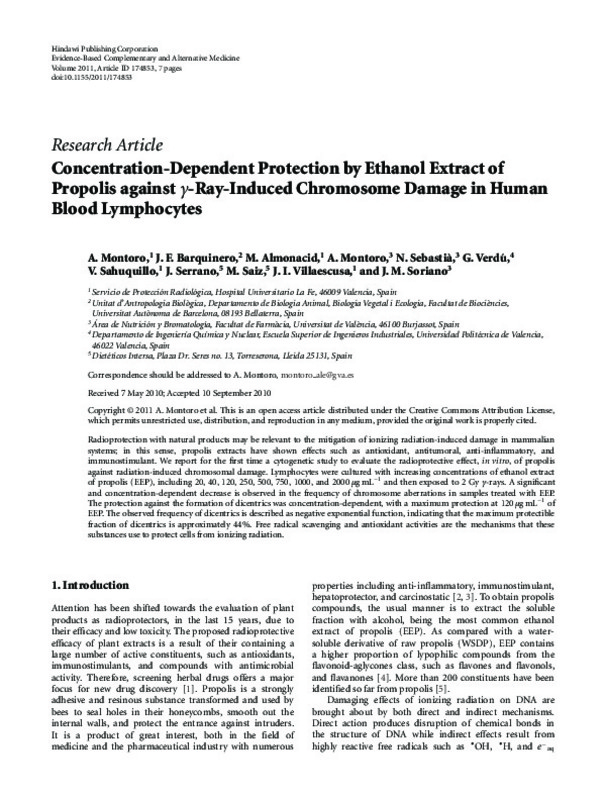Adams, K. L., & Wendel, J. F. (2005). Polyploidy and genome evolution in plants. Current Opinion in Plant Biology, 8(2), 135-141. doi:10.1016/j.pbi.2005.01.001
Adams, K. L., Percifield, R., & Wendel, J. F. (2004). Organ-Specific Silencing of Duplicated Genes in a Newly Synthesized Cotton Allotetraploid. Genetics, 168(4), 2217-2226. doi:10.1534/genetics.104.033522
Albertin, W., Brabant, P., Catrice, O., Eber, F., Jenczewski, E., Chèvre, A.-M., & Thiellement, H. (2005). Autopolyploidy in cabbage (Brassica oleracea L.) does not alter significantly the proteomes of green tissues. PROTEOMICS, 5(8), 2131-2139. doi:10.1002/pmic.200401092
[+]
Adams, K. L., & Wendel, J. F. (2005). Polyploidy and genome evolution in plants. Current Opinion in Plant Biology, 8(2), 135-141. doi:10.1016/j.pbi.2005.01.001
Adams, K. L., Percifield, R., & Wendel, J. F. (2004). Organ-Specific Silencing of Duplicated Genes in a Newly Synthesized Cotton Allotetraploid. Genetics, 168(4), 2217-2226. doi:10.1534/genetics.104.033522
Albertin, W., Brabant, P., Catrice, O., Eber, F., Jenczewski, E., Chèvre, A.-M., & Thiellement, H. (2005). Autopolyploidy in cabbage (Brassica oleracea L.) does not alter significantly the proteomes of green tissues. PROTEOMICS, 5(8), 2131-2139. doi:10.1002/pmic.200401092
Aleza, P., Juárez, J., Ollitrault, P., & Navarro, L. (2009). Production of tetraploid plants of non apomictic citrus genotypes. Plant Cell Reports, 28(12), 1837-1846. doi:10.1007/s00299-009-0783-2
Aleza, P., Juárez, J., Cuenca, J., Ollitrault, P., & Navarro, L. (2010). Recovery of citrus triploid hybrids by embryo rescue and flow cytometry from 2x × 2x sexual hybridisation and its application to extensive breeding programs. Plant Cell Reports, 29(9), 1023-1034. doi:10.1007/s00299-010-0888-7
Aleza, P., Juárez, J., Ollitrault, P., & Navarro, L. (2010). Polyembryony in non-apomictic citrus genotypes. Annals of Botany, 106(4), 533-545. doi:10.1093/aob/mcq148
Baack, E. J. (2005). Ecological factors influencing tetraploid establishment in snow buttercups (Ranunculus adoneus
, Ranunculaceae): minority cytotype exclusion and barriers to triploid formation. American Journal of Botany, 92(11), 1827-1835. doi:10.3732/ajb.92.11.1827
Bacchi, O. (1943). Cytological Observations in Citrus: III. Megasporogenesis, Fertilization, and Polyembryony. Botanical Gazette, 105(2), 221-225. doi:10.1086/335210
Barkley, N. A., Roose, M. L., Krueger, R. R., & Federici, C. T. (2006). Assessing genetic diversity and population structure in a citrus germplasm collection utilizing simple sequence repeat markers (SSRs). Theoretical and Applied Genetics, 112(8), 1519-1531. doi:10.1007/s00122-006-0255-9
Barrett, H. C., & Hutchison, D. J. (1978). Spontaneous tetraploidy in apomictic seedlings ofCitrus. Economic Botany, 32(1), 27-45. doi:10.1007/bf02906727
BRETAGNOLLE, F., & THOMPSON, J. D. (1995). Gametes with the somatic chromosome number: mechanisms of their formation and role in the evolution of autopolyploid plants. New Phytologist, 129(1), 1-22. doi:10.1111/j.1469-8137.1995.tb03005.x
Chen, Z. J. (2007). Genetic and Epigenetic Mechanisms for Gene Expression and Phenotypic Variation in Plant Polyploids. Annual Review of Plant Biology, 58(1), 377-406. doi:10.1146/annurev.arplant.58.032806.103835
Comai, L., Tyagi, A. P., Winter, K., Holmes-Davis, R., Reynolds, S. H., Stevens, Y., & Byers, B. (2000). Phenotypic Instability and Rapid Gene Silencing in Newly Formed Arabidopsis Allotetraploids. The Plant Cell, 12(9), 1551-1567. doi:10.1105/tpc.12.9.1551
Cosendai, A.-C., & Hörandl, E. (2010). Cytotype stability, facultative apomixis and geographical parthenogenesis in Ranunculus kuepferi (Ranunculaceae). Annals of Botany, 105(3), 457-470. doi:10.1093/aob/mcp304
Cuenca, J., Froelicher, Y., Aleza, P., Juárez, J., Navarro, L., & Ollitrault, P. (2011). Multilocus half-tetrad analysis and centromere mapping in citrus: evidence of SDR mechanism for 2n megagametophyte production and partial chiasma interference in mandarin cv ‘Fortune’. Heredity, 107(5), 462-470. doi:10.1038/hdy.2011.33
Cui, L. (2006). Widespread genome duplications throughout the history of flowering plants. Genome Research, 16(6), 738-749. doi:10.1101/gr.4825606
Dellaporta, S. L., Wood, J., & Hicks, J. B. (1983). A plant DNA minipreparation: Version II. Plant Molecular Biology Reporter, 1(4), 19-21. doi:10.1007/bf02712670
ESEN, A., & SOOST, R. K. (1971). Unexpected Triploids in Citrus: Their Origin, Identification, and Possible Use. Journal of Heredity, 62(6), 329-333. doi:10.1093/oxfordjournals.jhered.a108186
ESEN, A., & SOOST, R. K. (1973). Precocious Development and Germination of Spontaneous Triploid Seeds in Citrus. Journal of Heredity, 64(3), 147-154. doi:10.1093/oxfordjournals.jhered.a108373
ESEN, A., SOOST, R. K., & GERACI, G. (1979). Genetic evidence for the origin of diploid megagametophytes in Citrus. Journal of Heredity, 70(1), 5-8. doi:10.1093/oxfordjournals.jhered.a109188
Flagel, L. E., & Wendel, J. F. (2009). Evolutionary rate variation, genomic dominance and duplicate gene expression evolution during allotetraploid cotton speciation. New Phytologist, 186(1), 184-193. doi:10.1111/j.1469-8137.2009.03107.x
FROELICHER, Y., DAMBIER, D., BASSENE, J. B., COSTANTINO, G., LOTFY, S., DIDOUT, C., … OLLITRAULT, P. (2008). Characterization of microsatellite markers in mandarin orange (Citrus reticulata Blanco). Molecular Ecology Resources, 8(1), 119-122. doi:10.1111/j.1471-8286.2007.01893.x
Frost, H. B. (1926). Polyembryony, heterozygosis and chimeras in citrus. Hilgardia, 1(16), 365-402. doi:10.3733/hilg.v01n16p365
Saúco, V. G., Martín, M. J. G., Galván, D. F., Torres, A. C., Juárez, J., & Navarro, L. (2001). Occurrence of Spontaneous Tetraploid Nucellar Mango Plants. HortScience, 36(4), 755-757. doi:10.21273/hortsci.36.4.755
GERACI, G., ESEN, A., & SOOST, R. K. (1975). Triploid progenies of Citrus cultivars from 2x × 2x crosses. Journal of Heredity, 66(3), 177-178. doi:10.1093/oxfordjournals.jhered.a108607
Grant, V. (1981). Plant Speciation. doi:10.7312/gran92318
Grosser, J. W., Ollitrault, P., & Olivares-Fuster, O. (2000). Somatic hybridization in citrus: An effective tool to facilitate variety improvement. In Vitro Cellular & Developmental Biology - Plant, 36(6), 434-449. doi:10.1007/s11627-000-0080-9
Grosser, J. W., An, H. J., Calovic, M., Lee, D. H., Chen, C., Vasconcellos, M., & Gmitter, F. G. (2010). Production of New Allotetraploid and Autotetraploid Citrus Breeding Parents: Focus on Zipperskin Mandarins. HortScience, 45(8), 1160-1163. doi:10.21273/hortsci.45.8.1160
HAGERUP, O. (2010). ÜBER POLYPLOIDIE IN BEZIEHUNG ZU KLIMA, ÖKOLOGIE UND PHYLOGENIE. Hereditas, 16(1-2), 19-40. doi:10.1111/j.1601-5223.1932.tb02560.x
Harlan, J. R., & deWet, J. M. J. (1975). On Ö. Winge and a Prayer: The origins of polyploidy. The Botanical Review, 41(4), 361-390. doi:10.1007/bf02860830
Husband, B. C., Schemske, D. W., Burton, T. L., & Goodwillie, C. (2002). Pollen competition as a unilateral reproductive barrier between sympatric diploid and tetraploid
Chamerion angustifolium. Proceedings of the Royal Society of London. Series B: Biological Sciences, 269(1509), 2565-2571. doi:10.1098/rspb.2002.2196
Kamiri, M., Stift, M., Srairi, I., Costantino, G., Moussadik, A. E., Hmyene, A., … Froelicher, Y. (2011). Evidence for non-disomic inheritance in a Citrus interspecific tetraploid somatic hybrid between C. reticulata and C. limon using SSR markers and cytogenetic analysis. Plant Cell Reports, 30(8), 1415-1425. doi:10.1007/s00299-011-1050-x
Kijas, J. M. H., Thomas, M. R., Fowler, J. C. S., & Roose, M. L. (1997). Integration of trinucleotide microsatellites into a linkage map of Citrus. Theoretical and Applied Genetics, 94(5), 701-706. doi:10.1007/s001220050468
Koltunow, A. M. (1993). Apomixis: Embryo Sacs and Embryos Formed without Meiosis or Fertilization in Ovules. The Plant Cell, 1425-1437. doi:10.1105/tpc.5.10.1425
Koltunow, A. M., & Grossniklaus, U. (2003). APOMIXIS: A Developmental Perspective. Annual Review of Plant Biology, 54(1), 547-574. doi:10.1146/annurev.arplant.54.110901.160842
Krug, C. A. (1943). Chromosome Numbers in the Subfamily Aurantioideae with Special Reference to the Genus Citrus. Botanical Gazette, 104(4), 602-611. doi:10.1086/335173
LAI, Z., GROSS, B. L., ZOU, Y., ANDREWS, J., & RIESEBERG, L. H. (2006). Microarray analysis reveals differential gene expression in hybrid sunflower species. Molecular Ecology, 15(5), 1213-1227. doi:10.1111/j.1365-294x.2006.02775.x
Landry, C. R., Hartl, D. L., & Ranz, J. M. (2007). Genome clashes in hybrids: insights from gene expression. Heredity, 99(5), 483-493. doi:10.1038/sj.hdy.6801045
Lee, L. (1988). Citrus polyploidy - origins and potential for cultivar improvement. Australian Journal of Agricultural Research, 39(4), 735. doi:10.1071/ar9880735
Luro, F., Maddy, F., Jacquemond, C., Froelicher, Y., Morillon, R., Rist, D., & Ollitrault, P. (2004). IDENTIFICATION AND EVALUATION OF DIPLOGYNY IN CLEMENTINE (CITRUS CLEMENTINA) FOR USE IN BREEDING. Acta Horticulturae, (663), 841-848. doi:10.17660/actahortic.2004.663.152
Luro, F. L., Costantino, G., Terol, J., Argout, X., Allario, T., Wincker, P., … Morillon, R. (2008). Transferability of the EST-SSRs developed on Nules clementine (Citrus clementina Hort ex Tan) to other Citrus species and their effectiveness for genetic mapping. BMC Genomics, 9(1), 287. doi:10.1186/1471-2164-9-287
Manton, I. (1950). Problems of cytology and evolution in the Pteridophyta. doi:10.5962/bhl.title.4667
Masterson, J. (1994). Stomatal Size in Fossil Plants: Evidence for Polyploidy in Majority of Angiosperms. Science, 264(5157), 421-424. doi:10.1126/science.264.5157.421
Mather, K. (1936). Segregation and linkage in autotetraploids. Journal of Genetics, 32(2), 287-314. doi:10.1007/bf02982683
McClintock, B. (1984). The significance of responses of the genome to challenge. Science, 226(4676), 792-801. doi:10.1126/science.15739260
Muller, H. J. (1914). A New Mode of Segregation in Gregory’s Tetraploid Primulas. The American Naturalist, 48(572), 508-512. doi:10.1086/279426
Murashige, T., & Skoog, F. (1962). A Revised Medium for Rapid Growth and Bio Assays with Tobacco Tissue Cultures. Physiologia Plantarum, 15(3), 473-497. doi:10.1111/j.1399-3054.1962.tb08052.x
Ollitrault, P., Dambier, D., Luro, F., & Froelicher, Y. (2008). Ploidy Manipulation for Breeding Seedless Triploid Citrus. Plant Breeding Reviews, 323-352. doi:10.1002/9780470380130.ch7
Osborn, T. C., Chris Pires, J., Birchler, J. A., Auger, D. L., Jeffery Chen, Z., Lee, H.-S., … Martienssen, R. A. (2003). Understanding mechanisms of novel gene expression in polyploids. Trends in Genetics, 19(3), 141-147. doi:10.1016/s0168-9525(03)00015-5
Otto, S. P., & Whitton, J. (2000). Polyploid Incidence and Evolution. Annual Review of Genetics, 34(1), 401-437. doi:10.1146/annurev.genet.34.1.401
Raghuvanshi, S. S. (1962). Cytogenetical Studies in Genus Citrus. CYTOLOGIA, 27(2), 172-188. doi:10.1508/cytologia.27.172
Ramsey, J., & Schemske, D. W. (1998). PATHWAYS, MECHANISMS, AND RATES OF POLYPLOID FORMATION IN FLOWERING PLANTS. Annual Review of Ecology and Systematics, 29(1), 467-501. doi:10.1146/annurev.ecolsys.29.1.467
Ramsey, J., & Schemske, D. W. (2002). Neopolyploidy in Flowering Plants. Annual Review of Ecology and Systematics, 33(1), 589-639. doi:10.1146/annurev.ecolsys.33.010802.150437
Roche, D., Hanna, W. W., & Ozias-Akins, P. (2001). Is supernumerary chromatin involved in gametophytic apomixis of polyploid plants? Sexual Plant Reproduction, 13(6), 343-349. doi:10.1007/s004970100094
Saleh, B., Allario, T., Dambier, D., Ollitrault, P., & Morillon, R. (2008). Tetraploid citrus rootstocks are more tolerant to salt stress than diploid. Comptes Rendus Biologies, 331(9), 703-710. doi:10.1016/j.crvi.2008.06.007
SALMON, A., AINOUCHE, M. L., & WENDEL, J. F. (2005). Genetic and epigenetic consequences of recent hybridization and polyploidy in Spartina (Poaceae). Molecular Ecology, 14(4), 1163-1175. doi:10.1111/j.1365-294x.2005.02488.x
Schranz, M. E., Dobes, C., Koch, M. A., & Mitchell-Olds, T. (2005). Sexual reproduction, hybridization, apomixis, and polyploidization in the genus Boechera (Brassicaceae). American Journal of Botany, 92(11), 1797-1810. doi:10.3732/ajb.92.11.1797
Soltis, D. E., & Soltis, P. S. (1995). The dynamic nature of polyploid genomes. Proceedings of the National Academy of Sciences, 92(18), 8089-8091. doi:10.1073/pnas.92.18.8089
Stebbins, G. L. (1950). Variation and Evolution in Plants. doi:10.7312/steb94536
Stupar, R. M., Bhaskar, P. B., Yandell, B. S., Rensink, W. A., Hart, A. L., Ouyang, S., … Jiang, J. (2007). Phenotypic and Transcriptomic Changes Associated With Potato Autopolyploidization. Genetics, 176(4), 2055-2067. doi:10.1534/genetics.107.074286
Thompson, J. D., & Lumaret, R. (1992). The evolutionary dynamics of polyploid plants: origins, establishment and persistence. Trends in Ecology & Evolution, 7(9), 302-307. doi:10.1016/0169-5347(92)90228-4
Wang, J., Tian, L., Madlung, A., Lee, H.-S., Chen, M., Lee, J. J., … Chen, Z. J. (2004). Stochastic and Epigenetic Changes of Gene Expression in Arabidopsis Polyploids. Genetics, 167(4), 1961-1973. doi:10.1534/genetics.104.027896
Wang, J., Tian, L., Lee, H.-S., Wei, N. E., Jiang, H., Watson, B., … Chen, Z. J. (2005). Genomewide Nonadditive Gene Regulation in Arabidopsis Allotetraploids. Genetics, 172(1), 507-517. doi:10.1534/genetics.105.047894
Wendel, J., & Doyle, J. (s. f.). Polyploidy and evolution in plants. Plant diversity and evolution: genotypic and phenotypic variation in higher plants, 97-117. doi:10.1079/9780851999043.0097
[-]












